Canet d'Aude, history of our region
Canet d'Aude, 13km directly west from Narbonne, is situated just 1km south of the River Aude and thus is on the very north edge of the region called Corbières. It's history is worth looking at, as it could almost be the history of the region as a whole. I used to live there at one time and found many parallels and connections between it and Rennes-le-Château. Canet however is quite flat, bang in the middle of the flood plain of the Aude, and is not a mountain village.
The Romans
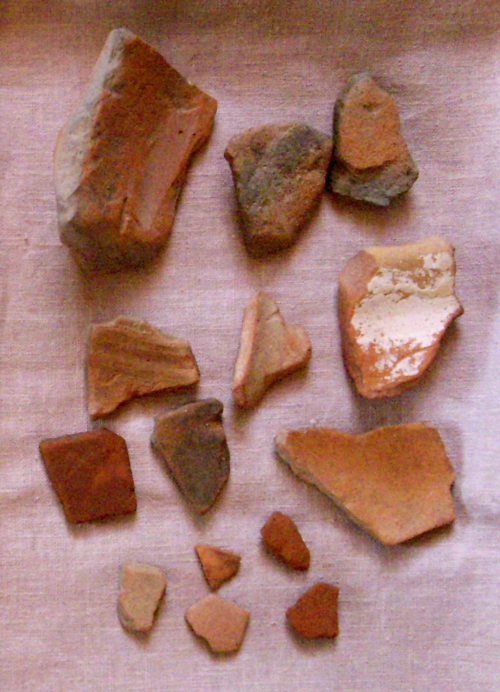 Roman pottery found at Canet
Roman pottery found at Canet
When the Romans first came to Gaul, as France was then known, the country was occupied by various Celtic tribes, while ports such as Marseille, Lattes and Agde had been built by the Greeks to facilitate trading. The Romans wanted to invest in this new country so built roads and founded colonies, around 40AD, often in the name of Julius Caesar. Béziers, on the site of a Celtic Oppidum, was called Colonia Victrix Julia Septimanorum Baeterae, while Carcassonne was named Colonia Julia Carcaso.
As part of this colonisation process, the Roman Rubrius brought 3000 soldiers and their families in 40BC from Narbonne north-west towards the Minervois, where they founded Roubia, on a south-facing slope, with its back to the mountains and its front surveying the flood-plain below. The settlements established on the south facing slope of the Minervois, at the northern edge of the flood plain of the Aude river, exist to this day. The Roman road from Narbonne to Roubia passed today's Canet and still exists. As the colonists went up and down from Narbonne for essential supplies, as they built their farms and small industries, the road became an established route.
To find it and walk along it, take the D607 out of Narbonne, then take the turning to Nevian just to the south of Marcorignan, then the first farm-track on the right. You are on the Roman road. It goes to le gué de l'Homme on the Orbieu. Gué means ford.
The road going through Canet has been called La Voie Dixiane. After le gué de l'homme, the road passes to the south of today's Raissac, then just to the north of Canet's centre to continue to the river Aude, then on to Roubia. Along this stretch I've seen a well with a cistern to store water. I found many fragments of amphores and roof-tiles beside it, as pictured above. Could there have been a building at this crossroad to service travellers? Of course. Further along is a bridge called Pont des Vignes, under which are the remains of a Roman bridge.
Roman villas? Some Roman buildings were what we would call farmhouses. These were the origins of St. Michel le Long, on the commune borders between Cruscades and Canet, and the grand domains of La Domêque and Fontarèche. At both places were found remains dated around 100 BC of pottery and amphores, (and remains of bodies at St. Michel) leaving us to believe they were some of the earliest Roman establishments in our region, as was Roubia.
The Romans did not settle at Canet, but there was a crossroads of Roman roads here, for the road from Cruscades, heading north to Ventenac and then Ginestas, crossed the Narbonne-Roubia road. One of the villagers found, among some tile fragments by the cistern mentioned above, a silver Roman coin with a head on it of Augustus who died in 14AD.
How did the Romans cross the Aude? I walked 3 km along the Roman road from Canet towards Roubia, looking for the place where the Romans crossed the river, and found a narrow but shallow place; I could hear the water tinkling over the stones. This must have been it! On checking the Carticulaire, (French book of the official history of Canet) I found that traces of a small building had been found on the field called Les Cadres, within easy reach of Fontarêche and directly opposite my calculated crossing spot! Another small building serving travellers?
Crossing a river was no problem to the Romans, they made rafts and would have swum their horses across. As well as crossing to Roubia, they went to Paraza to build a villa. They crossed the river at a place on the river where there is an island, to the west of the mill on the Aude in Canet. (In medieval times was a bac or ferry there.) The Romans also crossed towards Ventenac just to the west of today's modern bridge. I found some tiny remains in the field called Le Clot (between the tennis courts and the river.) The name "clot" is Roman, and refers to a depression in the land which remains wet for a long time after the rain. They crossed the Aude and it was a Roman mile before they reached the high ground - today's Ventenac. The village was still known as Villa Ventachus in 856. They built a villa to the east of today's road to Ginestas, also Roman in origin. I found many remains of rooftiles and pottery there.
Back to Canet. In the Carticulaire I found the following; "I know the Roman road that passes through Raïssac and Marcorignan to Narbonne. Around 100 years ago, my father went on foot to Narbonne using this road, which was still usable. It was 68 years ago, when I was 8, that he took me one day with him. In Narbonne the road went opposite the underground pathway which still passes below the railway line, where one went straight on to Les Halles." This was written in 1989 by Camille Dhoms, so it must have been around 1929 that he walked this road with his father. The road was still in use and the banks not yet built up as a flood protection. I bought my house in Canet from M. Dhoms' descendants.
The Visigoths
Here's where the connection between Rennes-le-Château became close.
The Visigoths are hardly mentioned in French history books which talk about the "paleo-chrétiens" and the "Carolingians." The Visigoths lived and governed in this region of southern France from 418 to 769! All the evidence we have (for many documents were destroyed by the invading Franks) imply that Canet as we know it today was founded in Visigothic times.
Below; the first tower the Visigoths built, on the left as seen from the château courtyard looking west, 2nd picture taken from rue du Parc to the south
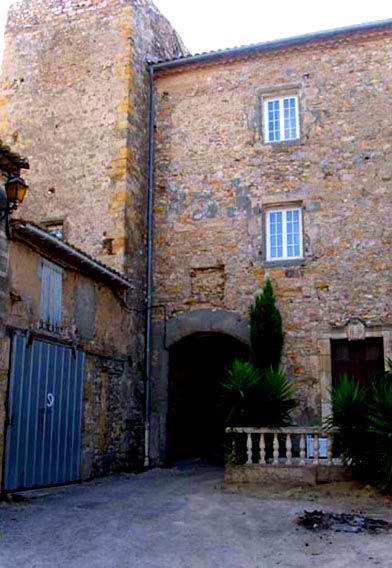
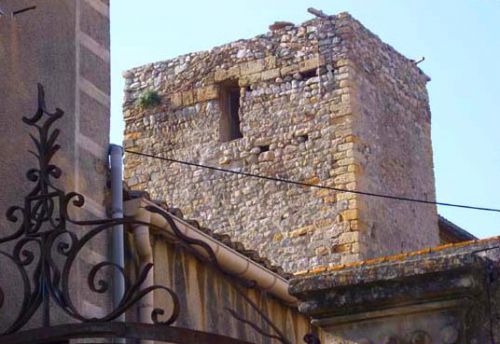
My knowledge of Rennes-le-Château inspired me here. The ground plan of the château in Canet was almost exactly the same as the ground plan of the château at Rennes-le-Château with a tower at each corner! I believe the Visigoths founded the château at Canet, because other castles in the region, that we know were founded by the Visigoths, have the same square shape with towers at the corners; in villages such as Rennes-le-Château, St. Ferréol to the south of Rennes, and to the west of it, Villarzel-des-Razès. Similarly, the church, or the chapel for the soldiers that began as the church, was directly opposite to the courtyard of the château. AND the church was originally rectangular in shape and had a tower beside it, constructed in the 17th century - just like Rennes-le-Château!
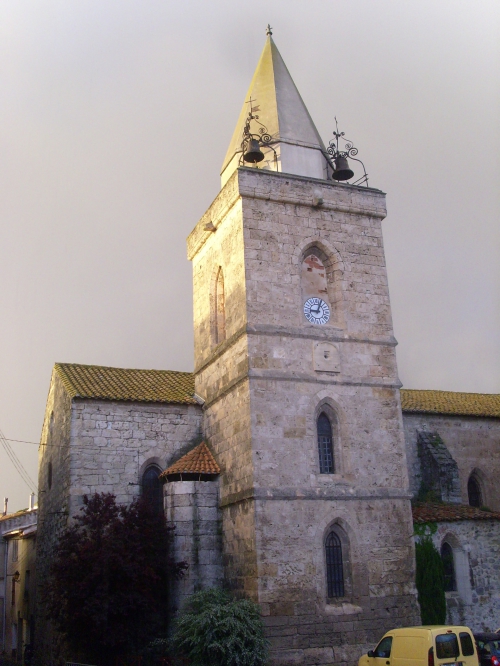
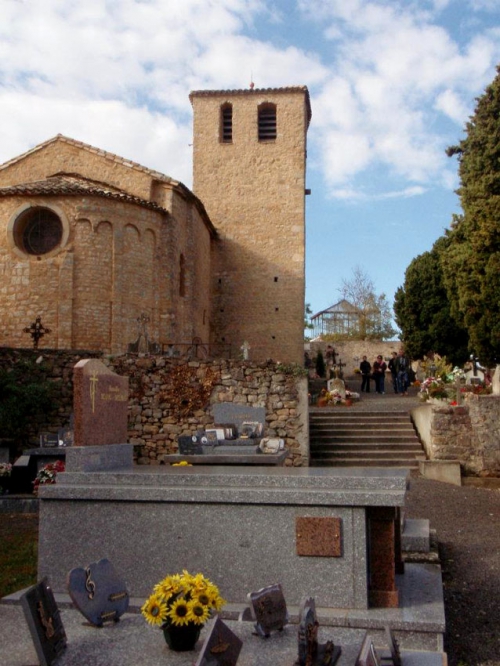
Canet on the left, RleC on the right. Take no notice of the rounded Carolingian end at Rennes-le-Château - that was added later. Both the buildings were originally small rectangular chapels, for the aristocracy from the châteaux to worship
Other evidence of Visigothic origins at Canet - a local person replacing vines on his land called Sanmacelle, behind today's graveyard, found fragments of pottery dating from Visigothic times. A Visigothic chapel was nearby, as is known from documentation, but no trace of this chapel exists today. It could have been destroyed when the Muslims came to the area; Guillem of Gellone (a Visigoth from Rennes-le-Château who became the favourite commander of Charlemagne) fought and lost near the Roman bridge at Villedaigne in 790. The name Sanmacelle means "St. Martial", who was the first bishop of Limoges in the 3rd century. Popular with the Roman soldiers - the Visigoths made up the bulk of the army - their chapel near Canet would have been dedicated to him. The field was named after the chapel to St.Martial.
The situation of this field was directly behind today's cemetary. One day they were cleaning the mud out of the ditches and I calculated on the map the exact place where the ditch was closest to the site of the now-disappeared chapel. I went along and sure enough, I found pottery remains in the mud dug out of the ditch. (Sometimes remains are as deep as six feet, this was about three.)
Other Visigothic evidence - at Maurou, near the field called La Chapelle, Visigothic stone tombs were found 60cm deep. Nearby were fragments from the first century BC, implying that the Visigoths took over a Roman establishment. Some think they buried their dead at Maurou after the "Battle of the Orbieu" and the place was named after the Moors. This battle was part of the defence of Narbonne. Later in 793 Charlemagne and his commander, Guilhem were obliged to defend the Roman bridge at Trèbes. (Guilhem came from Rennes-le-Château, called Rhedae then.) They failed, and had to pay a huge ransom to the Saracens, who then retreated.
How did the Visigoths come here to this region of Languedoc? After taking Rome in 410AD, the Visigoths entered two years of negotiation with Honorius the emperor and gained a foedus for Aquitaine. Under this arrangement, they administered the area as if it was their own, and sent a proportion of the taxes back to Rome. Their king Ataulf, with his beautiful bride-to-be, Galla Placidia, came to Narbonne where they were made welcome; Ataulf was a Roman Consul. From Narbonne and Barcelona, Ataulf sent out exploratory parties to investigate the territory and report back on potential sites. During this time various villages were founded, including Rennes-le-Château, Douzens - and Canet.
A Visigothic reconnaisance party came along the Roman road from Narbonne towards Roubia. How could they defend this vast flood plain, covered with marshes and reeds, just to the south of the Aude river? To their left was a small mamelon, as the French call hillocks, and it was rocky; the silt from the floods had not risen above it. You can still see this bedrock in the Cour du Château at Canet. They had found firm foundations for their watchtower to guard the region. The mamelon was surrounded by marshes and brooks; so they built what is now the south-east tower of the castle, on the highest point of the mamelon. The nearness of water kept the ditches full; with palisades behind them, the château, as it later became, was kept secure.
By 418 the Visigoths had reached Aquitaine and settled in the Roman town of Tolosa, today's Toulouse, which they made their capital. But they really wanted the Narbonnais, with its port on the étang. Eventually, in 462, they gained Narbonne under king Euric and reached the height of their powers, controlling Aquitaine, Languedoc, the Auvergne and much of Provence; as well as Spain.
The Franks from the north attacked in 507, reducing the Visigothic territory to Spain and the Languedoc, then called Septimanie. Septimanie included Narbonne, Carcassonne, the Visigothic citadel of Rennes-le-Château, and Canet. Septimanie was important to them, and must now be better defended, especially against attacks from the northern half of Gaul.
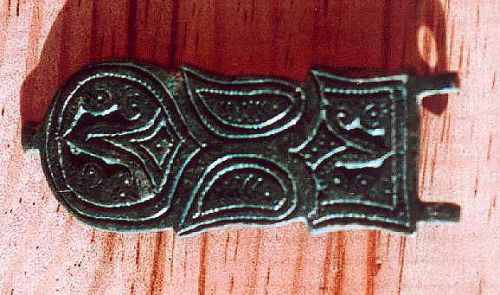 A Visigothic belt buckle found at Montrabech in the commune of Canet
A Visigothic belt buckle found at Montrabech in the commune of Canet
It was at this time then, between 462 and 537, that the château at Canet was enlarged and two more towers built, on the north-east and north-west corners of the square central enclosure. Because the ground fell away to the north and the west, the new building meant there was space towards the south for many cellars and dungeons. The current owner of the château took me to see these; and he held the torch so I could photograph the Visigothic secret passage that went down to the Jourre. There were no ramparts, just a timber palisade built inside the stream called Rou, which still exists and encircles today's ave de la Promenade, passing under the pavements.
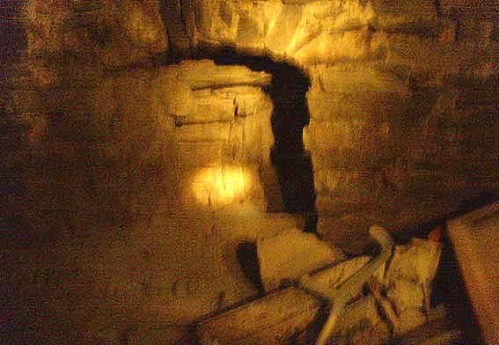
The legend said this underground passage went to the fortress on the river and so was an escape route. There are similar legends at Rennes-le-Château. In fact, it was Visigothic practice that, in times of siege, soldiers could escape through the underground passage and then circle round to attack the beseiging enemy from behind. Clever, that.
The Visigoths were Christians, but not in the Roman style, they believed the teachings of the Alexandrian priest, Arius, who said that "Jesus was not of the same substance as the father." The Visigoths believed in Jesus and his teachings, but not in the Trinity. Now that the defences were reinforced, and more people plus a garrison were living at Canet, the people needed a church. Sometime in the 6th century, the Visigoths built their church just down the east-facing slope from the castle, with its entrance opposite the château entrance. It was a simple rectangular building with a window at the east end so the rays of the morning sun entered the church. They probably had a horseshoe-arch separating the altar from the nave; you can see this in other Visigothic churches, at St. Martin-de-Puits in the Corbières and the chapel of St. Laurent near Moussan.
About 700 metres away, they built their graveyard at Sanmacelle with its tiny chapel to say prayers for the dead. It was their custom, to build graveyards apart from where they lived, for hygienic reasons, as you can see at Capendu on the Montagne d'Alaric and at Cabanes de La Palme to the south of Sigean, where is the beautifully restored chapel of St. Pancrace.
Meanwhile the Spanish Visigoths and the Septimanian Visigoths argued, especially since the conversion of King Recared in Spain to Roman Christianity, which led to the persecution of the Jews, who therefore sided with the Muslims when they invaded Spain in 711. During this time, 673, the Spanish Visigothic king Wamba came to put down the Septimanie rebellion; the Arian Visigoths here did not want to be Catholics and did not want to be ruled from Toledo.
Wamba chose a route back to Toledo that went through the Corbières. Just after Narbonne he stayed at somewhere called Canaba on the river Orbieu. I thought this must have been Canet! But author Jean Alain Spira has proved Wamba's stopover to be the place now called Villemouvette, on the south side of the Orbieu, after which Wamba went to what is now Ornaisons to pick up the Roman road to Spain, via Mouthoumet and Rennes-le-Château. Why did he go to Rennes-le-Château? It's thought he was hunting for the hidden Visigothic treasure. This is all in the book by Spira.
After the Muslim invasion of Spain, from 711 to 718, the Spanish Visigoths retreated to Septimanie, where life was more liberal; it was a trading area, and many nations lived side by side in cosmopolitan Narbonne. The Muslims made exploratory visits to Gaul and history has made much of the valiant Charles Martel saving France from a Muslim future. In fact, in 737 in Languedoc, Charles Martel attacked anyone who was not Roman Christian; Jews, Muslims and Arian Visigoths alike. He failed to take Narbonne and in a temper he ravaged the whole region, burning and destroying towns, villas, domains, and left Septimanie a wasteland. He destroyed legal documents, leaving vast holes in the history of the Visigoths. The notice seen at today's Lastours on the River Berre, says; In 737, Charles Martel defeated the Saracens between Lastours and the étangs and killed their king, Amor. The region was then devastated, a desert surrounded by deserts. In the 12th century, the Via Mercaderia built by Ermengarde of Narbonne, passed directly at the foot of the château, giving back to Lastours all its splendour.
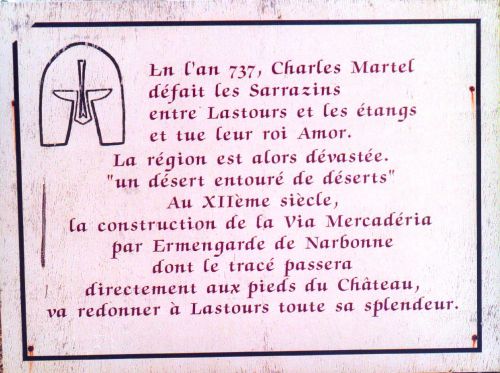
When Charlemagne inherited the kingdom in 769, he was obliged to resurrect this "waste land." As part of his scheme to re-vitalise the Corbières, he gave grants to various Visigoths from Spain to enable them to settle and re-build the region, like "Jean the Visigoth" who founded Fonjoncouse. (Durban and Lézignan were founded at this time.) One of these families was called Canedos.
Canet had its name already; the Romans named the marshy region "Canna" after the reeds that grew there. In Occitan these reeds are called cagnoto or canote. So our Spanish Visigothic friends called themselves "de Canet" or "from Canet", and the de Canets of Visigothic descent were accepted as the seigneurs of the village.
In 768 Charlemagne negotiated with the Visigoths in Narbonne; Narbonne could continue its way of life, with all nations living at peace, as long as the Muslims left and the town was nominally French. The Muslims were evicted and Narbonne became Frankish under the rule of the Arian Visigoths and the Jews. The Jewish kingdom in Narbonne lasted until the 14th century, when the Jews were persecuted by Philippe le Bel - a disastrous blow to Narbonne's economy. The Jewish leader was traditionally known as Nassi, which the Christians interpreted as "king of the Jews."
From 769 the Visigothic nobility intermarried with and were absorbed by the French - although their descendants lived in the region for a long time and some still do - but a rebellious and aging Visigothic Count, Milon, tried to revive Arianism. Daniel, the archbishop of Narbonne at the time, managed the situation amicably and so (the document still exists) on the 3rd of June 782 Charlemagne gave Canet to Daniel as a reward. Canet included Fontarêche and was described as a fortified village on the site of a previous château, leaving us in no doubt that Canet was previously Visigothic. (Village fortifié à l'emplacement de l'ancien château.)
We do not know what the de Canet family thought about their home being given away over their heads, but we can guess.
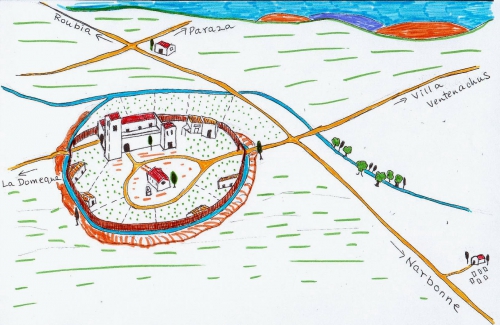
My impression of Canet around 700AD
Medieval times
In Carolingian days, devised by Charlemagne, the system of allegiance came into play, in which every man owed allegiance to somebody above him, the highest being the King. This basic political structure did not alter much until the Revolution. On the principle of choose your men and then leave them to get on with it, Charlemagne founded many abbeys, which gave homes to poor men who needed to work, and he copied an Eastern church system of appointing archbishops to rule several bishops. The Bishop of Narbonne, who owned Canet, became one of the first archbishops.
In the 9th and 10th centuries, under the jurisdiction of the descendants of Charlemagne, the Jews, who administered the vast estates of the archbishop, were asked to put in place a water disposal system so that with proper drainage, the region of Canet could release the fertility of its soil. The Jews rescued the land from the water. They were owners of mills under the Roman bridge in Narbonne and estates in the countryside. In Narbonne, their houses crowded round the Viscounts' palace and the area cut in half by today's rue le l'ancien Courrier belonged to the Jews.
Canet and the ambitious Archbishop
Guifred the archbishop of Narbonne served from 1019 until his death in 1079. He did not come from a religious family but an ambitious one. Especially widespread in the Cerdagne (today's Catalonia) the family wanted one of their own people in valuable Narbonne. Guifred's father bought the office of Archbishop for him when Guifred was ten years old. AND "all of the Razès" - Rennes-le-Château country.
At his initial appointment Guifred promised his patron, the Viscount of Narbonne, half of his property, the towns and castles of Salses and Castelnau in Roussillon, plus half of his future inheritance from his uncle, the Count of Bésalu (in northern Spain.) However, once he was established he started a campaign to increase the archbishop's power in Narbonne and its region. He perused old documents dating back to Charlemagne's time and the original gift of Canet to the archbishop. These, in copying, then became subtly changed so the archbishop had more power and riches. Then Guifred stripped the cathedral of Narbonne (not today's which was buit in 1272) of all its valuables to buy the Cerdagne town of Urgell for his brother.
The Viscount begged the Pope to take Guifred to Rome in chains and punish him. In 1059 Guifred was excommunicated by the Pope and in response he enlarged a ring of castles around Narbonne. These included Capestang and Salles, guarding the marshes between Capestang and the sea, overlooking the Roman road of Via Domitia, and Canet, which guarded any approach from the west; through Toulouse, Carcassonne, Argens, Conilhac and Cruscades. He also had a fortress on the river Orbieu at Villedagne - I have found traces of this. The Orbieu, which means "blue gold" carried allevial gold all the way from Albières and Auriac, to join the Aude which then went through Narbonne. Guifred controlled all that, and the castle at Albières.
The château here at Canet was enlarged, and the south-west tower, called the Archbishop's tower, was built then. His coat of arms was placed on the tower; you can still see where it was chipped off after the Revolution. The tower contained the private apartments of the archbishop upstairs, downstairs were the quarters for the bodyguards. Guifred had his own army of of knights, who had already seen action when his power was disputed by the Viscount of Béziers, who was then obliged to backtrack over a dispute of the ownership of Capestang. Guifred's soldiers had horses to be stabled; two wells were sunk in the downstairs quarters on the south side of the château. Here were the soldiers' quarters and the dungeons built in Visigothic times.
Guifred also built a fortress on the river Aude to the north of Canet. It is still there, with its massive walls of square cut stone, tiny slits for arrows, and its watchtowers, from the roofs of which his soldiers could watch for anyone coming across the countryside or sailing down the river; the river traffic into Narbonne and then to the sea was immense. Since Roman times goods had travelled along the rivers. At the time the Aude passed through Narbonne, but the river changed its course at Sallèles d'Aude during a storm and flood in the fourteenth century.
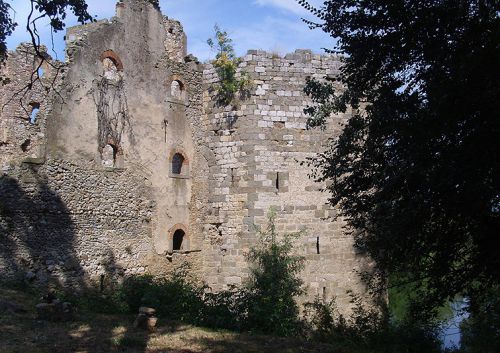
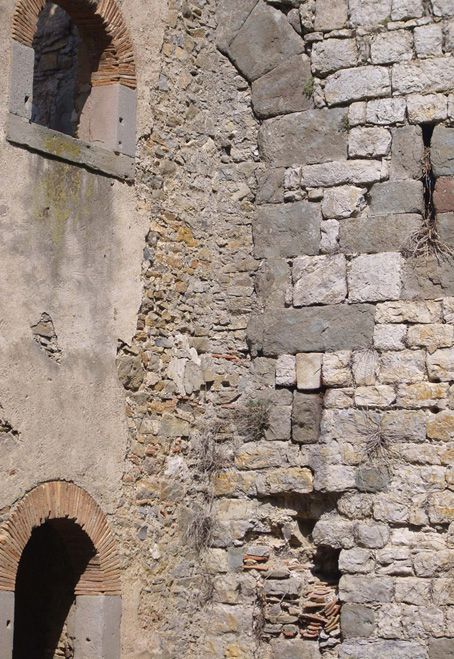
See the 1059 stonework on the right; to the left is the flour mill, which the fortress became in the Middle Ages.
By now Guifred controlled all the trade routes in and out of Narbonne and the Cerdagne. His fortifications worked. Canet has never been taken in battle.
Meanwhile however, that year 1059 was decisive in another way. We read that the church to Mary Magdalene in Rennes-le-Château was consecrated to her by Guifred, the Archbishop of Narbonne, in 1059. I read in a reputable history book that Guifred was on the run from his enemies (the Viscounts of Narbonne) in 1059 and so he "took shelter in an unconsecrated church" - so he consecrated it. That is amazing!
Then the official history of Alet-les-Bains kicked in. The Count of Carcassonne and the Viscount of Béziers were accused of "violating the abbey" of Alet les Bains in 1059. They had insisted on entering the abbey to arrest two military men and had executed one. The Viscount of Narbonne, Raymond Bérenger, was a relative of the executed knight and "involved at the time in great disputes with the Archbishop of Narbonne." Yes, this was the same Guifred who consecrated the church at Rennes-le-Château when he was on the run. Well, as the Archbishop of Narbonne he gave his pardon to the two lords of Carcassonne and Béziers and they were then obliged to support him against Raymond Bérenger, the Viscount of Narbonne. It was safe for Guifred to return to Narbonne. I had always wondered why Guifred, the Archbishop of Narbonne, apparently travelled all the way to the remote village of Rennes-le-Château to consecrate it; now we know.
Even so, it begs the question; if the church at Rennes-le-Château was not consecrated before 1059, what was it before? Arian? Cathar?
Guifred died in 1079 and the Viscounts of Narbonne tried to reclaim the rights he had taken. The archbishop in the cathedral, and the Viscounts in their palace on the other side of the Via Domitia, were bitter rivals for power. Many attempts were made to recover the original Carolingian documents. Everyone felt they had been forged, but it was too late, and the archbishops awarded themselves yet more rights.
In 1110 Bernard de Canet and his brother Remi tried to claim back Canet; the charter exists, telling them to desist. However, they kept on fighting and managed to regain certain rights, notaby for protection in times of trouble, but on condition that if the family died out Canet would revert totally to the archbishop.
Bernard of Canet and the Vicountess
Narbonne was inherited in 1142 by the lovely young Viscountess, Ermengarde, whose father and two older brothers had died. She was soon married to Alphonse of Toulouse. It meant she had to give him Narbonne as her dowry. Alphonse had been in Narbonne for three years, so she knew him, but he might have pushed her into marriage as soon as she was twelve years old, deemed adult for girls (fourteen for boys) at the time. We don't know if she was willing or not, but she drew up her own marriage contract. "Be it known to all present and future that I Ermengarde want you Alphonse for my husband and give myself to you as your wife. By the same donation I give you Narbonne entirely without fraud on the condition that we hold it jointly in our lifetimes and after our deaths it will belong to the children we have procreated. If we have none who survive us and you survive me, you shall have and possess Narbonne and all that goes with it as long as you shall live."
The politics of the time were complicated, and the Trencavels, from Béziers and Carcassonne, had close bonds with Narbonne, as did the house of Barcelona. Alphonse of Toulouse had been threatening Narbonne for some time. He had the archbishop of Narbonne on his side, Arnold of Levesu, who probably officiated at the wedding. Alphonse rewarded him in 1142 by giving him the fortified town of Conilhac - one of Guifred's original ring of castles. Canet was also an archbishop's castle, and the de Canet family were more than interested in getting Canet out of the archbishop's hands and into their own, as Conilhac had done, before being given away again. The Canet family thus supported the Trencavel action against Ermengarde's new husband as it was felt they had to save Ermengarde's independence and that of the city. Two Bernards of Canet, father and son, were most important in Ermengarde's entourage, witnessing legal acts from 1112 to 1153 and sometimes negotiating them. In his will of 1154, Raymond Trencavel placed the administration of Béziers and Carcassonne under Bernard of Canet's supervision, Bernard's son of the same name specialising in Carcassonne.
Within a month of Ermengarde's marriage there was open war. The Narbonne nobility tried to depose Alphonse. Alphonse was defeated and imprisoned, under the guard of Bernard of Canet. Could Alphonse have been kept prisoner here at Canet? Eventually, Alphonse signed over everything to Ermengarde and the marriage was annulled. We have the Treaty. "Alphonse, le comte de Toulouse, fit la paix quelques temps avec Roger, vicomte de Carcassonne; Ermengarde, vicomptesse de Narbonne, et quelqu'uns des autres seigneurs qui s'étaient legués contre lui. Ce traité fut négocié par Bernard de Canet. Le compte de Toulouse enounce au serment de fidélité fait par les habitants de Narbonne (qu'il avait prise) et des environs. Bernard of Canet controle l'application du traité." It says the treaty was negotiated and later controlled, by Bernard of Canet
A new husband was found for Ermengarde, Bernard of Anduze from Nîmes. Bernard was about forty, with children from a previous marriage. It was a marriage of convenience, so nobody else could claim her dowry of Narbonne. We don't know what she thought and felt about all this, but within a year she took up the reins of power and held them until her death in 1196, when her nephew briefly inherited before the Viscounty returned to the Aymeri's (of Visigothic descent.) She never married again, but was the centre of the troubadour culture, with its courts of love, where many think she found a lover. The Canet family remained in her entourage and were faithful to her. They tried to regain Canet in 1157 and 1165, but Acts signed by the King confirmed that Canet was to remain in the hands of the archbishop.
Ermengarde has recently captured the public's imagination, and festivals in her name are held in Narbonne every year. Ermengarde never forgot Guifred and constantly tried to establish Viscountal reign and reduce the power of the archbishops. At the time it was business routes that were important, for the owners of roads, bridges and so on could extract tolls, which brought in a fortune, and so Ermengarde built an alternative route (from the Via Domitia, which was falling into disuse) across the mountains to Cerdagne. A bridge still exists at Lastours on the Berre.
The growth of Canet
The ramparts were built here about 100 years after Guifred had made the town well-defended, as the narrow gates opened out onto marshes. The north gate still exits, beside it, and a tower of the ramparts. Another round tower, invisible from the ground, is part of a house in the old town. Many of these houses were originally built leaning against the ramparts which still form their northern wall. Some have a gap between them and the ramparts; the sentries used to walk this narrow path to protect the town. The ramparts were buit in the 12th century, as was the enclosure of the château courtyard. There's a mystery here, however, because if you look closely at the entrance into the château courtyard, you will see two arches built at different times.
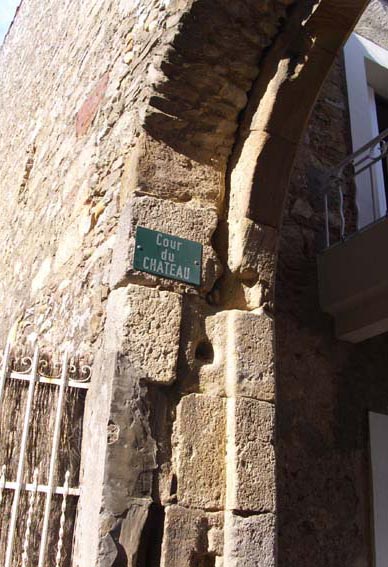
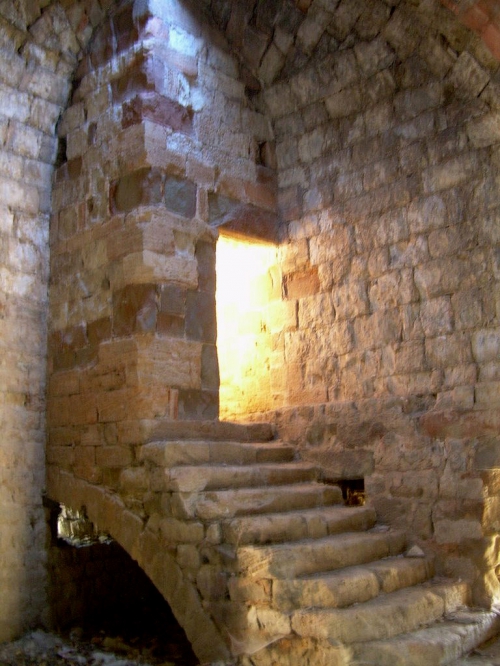
The entrance to the château courtyard; more medieval architecture inside the moulin
Later in 1237 the fortress on the river Aude became Canet's le moulin. You can clearly see the difference in architecture. A barrage was built across the river, making a millrace; this water turned the grindstones inside the mill. It ground corn to flour which made Canet and the archbishop very wealthy. More attempts were made to wrest Canet out of the hand of the archbishop, for letters from the Pope, affirming all the archbishop's rights, exist from 1163 and 1230, and again in 1294. Canet remained the property of the Archbishop of Narbonne, whoever he was, until the Revolution of 1789.
Meanwhile, the Crusade against the Cathars began under Simon de Montfort in 1209. In 1216 he made his headquarters at Lézignan and tried to claim various properties in the region, including Canet, and once again the Pope supported the rights of Narbonne's archbishop. The names of the Canet family disappeared about this time. Their daughters married away and the men perished in the Crusade against the Cathars. Were they Cathars? Their Visigothic descent, and their hostiity towards a financially grasping church, would imply so. Then Canet belonged to the archbishop of Narbonne until the Revolution.
The Black prince
He was called this because his armour was black. He was the son of Edward III of England, although his great grandfather was Philippe le Bel of France. He invaded Bordeaux and marched to Narbonne with an army of English and French troops; they were from Aquitaine and the English owned Aquitaine at the time.
On the 7th November 1355 he arrived at Puicheric and crossed the river Aude by the ford to Castelnau. He lodged his army at the château of Sérame, which belonged to his friend Dame Yseult of Brittany. He continued, via the old Roman bridge called the "Pont des Vignes", to Canet and spent the night there, in the Archbishop's tower. His army of 15,000 men was billeted partly at Canet and partly at Villedaigne. Then the Prince and his army crossed the river at the ford near Raissac and continued to Narbonne. This story proves the Roman road passing Canet, going from Narbonne to Roubia, was a major route in 1355.
The Black Prince never burnt and pillaged Canet or Lézignan but he did demand ransoms.
After his visit, it was time for Canet, with other villages, to reinforce their fortifications, just in time, for they were well-defended when the region was menaced by routiers - Spanish bandits - in 1360. These were the ones that attacked Rennes-le-Château in 1362. When peace came, people worked with the new crops, such as the dyes indigo and pastel, and the new foods, such as haricot beans and maize. Canet was important in the 14th century. It had an olive oil mill, a hostel for pilgrims and its own Court of Justice answerable only to Carcassonne. The record exists of a man who was sentenced to be hung, for the theft of a mule and some sheep, but Carcassonne modified his sentence to banishment - with his hand cut off.
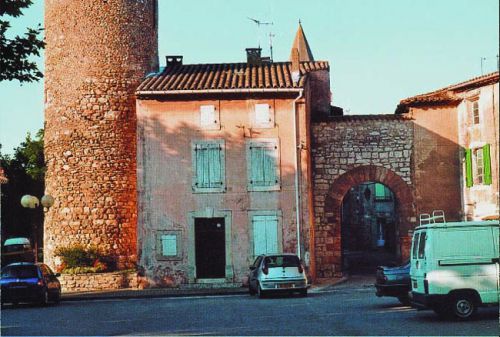
Part of the medieval ramparts still exists, the tower on the left, the North gate on the right. Between them, a house built against the ramparts, hiding the guardhouse by the gate.
The Sixteenth century
In 1558 King Henri II gave permission for a ferry to operate between Raissac and St. Nazaire d'Aude. At this time bridge building was expensive and trade and sheep-herding routes were opening up, so fords and ferries became popular. The ferry was under the jurisdiction of the Archbishop of Narbonne and the village people had to pay for it and maintain it; but they were exempt for the two pennies fee to cross the river (four pennies for a horse.) Old photos show the ferry to be a flat-bottomed boat with a woman on it poling it across the water. It's a quirky bit of history that ferrymen were always women, no-one knows why. It was 1957 before this ferry was abandoned. There was also a ferry or bac at Canet, connecting it to Paraza. Ruins of the so-called boatman's house still exist, but maybe his daughter did the work!
In 1609 The Provincial Council of Narbonne decided that schoolmasters and schoolmistresses, usually appointed from among the religious, should be appointed in villages, and they were regularly visited to ensure they were teaching the children what the archbishop wanted them taught - official church dogma. The children were taught morals. Girls had to cover themselves modestly when talking to boys and men and they mustn't share a bed with their brothers. This was hard, for in poor familes, they all slept together.
The Sun King
In 1659, when Louis XIV was still under the care of his mother and Mazarin as regents, Nicholas Fouquet tried to seize power. Fouquet's brother, François, became the archbishop of Narbonne, and maybe he too was fabulously rich, for he re-built the château of Canet as his private country house. The last Fouquet brother, Louis, was also a churchman, and here we touch again on the Rennes-le-Château mysteries, for young Louis was despatched to Rome, where the painter Poussin was living at the time. Louis wrote to Nicholas Fouquet in Paris and said; He and I (he's refering to Poussin) discussed certain things . . . . things which willgive you, through Poussin, advantages which even kings would have had great pains to draw from himand which it is possible nobody else will ever discover in the centuries to come.
Nicholas Fouquet was arrested soon afterwards and locked up, although never formally accused of any crime, and Louis XIV searched for a purchased thepainting of the "Shepherds or Arcadie" which went into this private apartments in Versailles. It's thought the tomb in this picture was the one at Arques near Rennes-le-Château.
In 1759 our château was inspected by experts on behalf of the archbishop, Charles-Antoine de la Roche-Aymon. Much work needed to be done! The arch and walls to the courtyard needed re-building and something must be done about the horse-droppings. The kitchen needed a new oven and two new windows. The windows of the chapel must be unblocked. All the walls needed to be rendered and the workers would have to be lodged in the stables. The Archbishop's apartments were especially in need of repair. The park, which in the time of François Fouquet, had Muscat vines, herbs, fruit trees, walkways and a 700m long aqueduct of terra cotta feeding water from La Jourre, had been turned over to corn. The batelier's house was in a bad state and was also renovated. They reported on the mill, from where, legends say, underground passages connected it to the château.
The eighteenth century in Canet was marked by the demands of the curé upon the council. He wanted repairs for his presbytère, then a fine stone house; but the consuls, as they were called them, wanted the church repaired and tried to charge him with maintaining the clock; it all makes amusing reading with hindsight, but when the curé died in 1757, his nephew inherted from him and continued the battle!
The last archbishop of Narbonne, Monseigneur Dillon, used to come with twelve servants to Canet for the hunting. Those happy days were soon to end for him; he fled to England where he later died. His tomb was found in St, Pancras graveyard in London and his remains have recently been brought back to his native Narbonne.
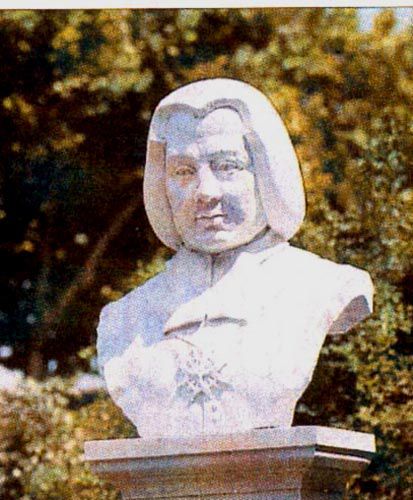
The Revolution
The attack on the Bastille on 14th July 1789 was no great thing, although it triggered the Revolution. Only 18 prisoners were released, including the Marquis de Sade, imprisoned for his pornographic writing. Citizen Sade led the prisoners out over the rubble in the breached walls. 14th July is celebrated every year as a national holiday and a symbol of equality, brotherhood and freedom, and the date has become magic for the whole of France.
In the summer of 1789 the political news from Paris hinted of the desperate state of many people exploited by the aristocracy and the church. Having been told the "people" now owned wealthy properties, they looted castles and churches, with the loss of many valuables and documents. Some villages, and certainly Lézignan, established patrols to defend the people from "vagabonds."
In Canet the crest of the archbishop was removed from the château entrance. Suddenly the church had lost all its power. Some priests fled to Spain. Some villages took the valuables from their churches and hid their priest. In nearby St. Nazaire, a local citizen, even if he voted Republican, sheltered the curé.
The Assemblée Nationale Constituante decided in Paris, in November 1789, that "les biens du clergé sont mis à la disposition de la nation." Thus, the goods of the church, in the Narbonnais region, were sold off between 12 January 1791 and 17 November 1815. The first sale at Canet was the château and park. Bids above a certain estimation were demanded. Eventually a Monsier Bonnes offered 37 000 livres and it was accepted on 22nd February 1791. He was allowed to pay in several installments, carrying a tax of 5%. Then came le moulin du blé, which included the ferry across the Aude and the batelier's house. It was sold for 44 000 livres to Jean Barthès. He was supported by local dignitaries to pay in installments, signing the bill of sale on 1st april 1791. In October followed the sale of the presbytere or curé's home for 200 livres, again, paid in installments over a year. And lastly, the local bread oven, which, with its profit, belonged to the archbishop, was sold to Louis Rossignol on the 8th January 1793 for 4 000 livres; its value had been estimated at 500 livres.
This bread oven still exists just across on the south side of place de l'Eglise. It was new when it was sold, for the plaque on the building says 1781. You can see the chimney above the roof tops. These two houses were once one, until separated by an inheritance, and you can see how they later had a baker's shop, by the markings on the frontage. Communal ovens were common in Languedocian villages; one kneaded one's own bread, and took it along, for a small fee, to be baked in the communal oven. The men were usually sent to do this job and tables and chairs were provided so they could sit and gossip while the bread was baked.
On 21st september 1792 the Republic was proclaimed. The Canet curé, Joseph Tien, would not preach Republicanism, as a priest had to do by law, and so was declared an emigré. He was replaced by curé Chaud, who said a few masses, then declared himself de-frocked - and then got married!
King Louis XVI was tried in Paris in early 1793. The delegates from Aude included Michel Azéma, a 40 year old lawyer from Argeliers. He gave a passionate speech describing the crimes of the King against the people, and was therefore a great influence on the final vote, which was very close. He was supported by a young barrister from Limoux called Bonnet, and by Ramel-Nogaret from Montolieu and Giraud from Narbonne. The vote was 361 for an immediate death penalty, 290 for other punishment, 70 for a deferred death penalty, and 28 abstentions. Michel Azéma's famous saying is; "Aucun Azéma n'est jamais monté à une position comme la mienne; j'ai été plus d'un roi, car j'en ai jugé et condamné un." (No other Azéma has ever climbed to a position like mine. I am more than a king, for I have judged and condemned one.)
Since the Revolution, Aude has always been the "reddest" departement of France.
The Nineteenth Century
At the turn of the century, grape-pickers' feasts arrived! On the last day of picking, people were offered a free feast; one meal was listed to include bread, onions and garlic, green salad, fish including morue, various meats and fruit. Naturally last year's wine had to be finished up and then there was dancing.
In 1820 the population of Canet was only 600, and the children lacked instruction. In theory, education after the Revolution was provided by the state, but in practice, at Canet they made do with a master and a mistress, and the curé helped out by giving lessons in his home. School became free and obligatory in France in 1882, and this probably prompted the building of the school, paid for by the commune, in 1891. Instead of religion, children were taught "moral values" and they were also taught French, in preference to Occitan, which was spoken by most people in our region up until the 1950's.
In 1850 the cemetary, situated where in now the school playground, was removed to its present location on the Raissac road, due to Revolutionary re-organisations common at the time. All the graves were removed as well. The church was renovated in 1849, with great debates by the municipal council as regards the work and the cost. Churches were now municpal buildings. They are exempt from paying rates and events are held in them, such as art exhibitions.
The door of the church was moved to face east; you can see the outline of the old door, opposite the château. Notre Dame de Canet in her side chapel "was separated from the faithful" by a grill, and her cult diminished litle by little. So on 8th September 1913 she was placed in her present position by abbé Lucien Ganteau and she is still fêted on that special day; the Virgin Mary's birthday. Since 1913 her chapel is always lit by lamps, day and night. Notre Dame de Canet is now classified as an historical monument and she is very beautiful. In her chapel in the church is a statue of her mother St. Anne, with the boy Jesus, both dressed in gold.
My own house was built about this time, along with the two other houses beside it. I have a well in the cellar and it seemed so badly placed, directly in front of a side entrance to the cellar. When I mentioned this to an adjunct from the Mairie, he commented; "Ah! Maybe the well was there before they built the house." In that case place de l'Eglise, called simply la Place at the time, had two wells for there's another water supply, still in use, beside the church. I had a look down my own well and the stonework seems older than 1850, and the building method quite different to that of the house.
The fruit of the vines
In 1843 the floods were so bad that the wine harvest was lost and the damages calculated for Canet stood at 65,000fr. None the less, vines became the main crop of the village about 1850, and in that same year 50 people out of the population of 650 contracted a fever. It was traced to pollution of the river Jourre and a law was passed to make this pollution, done by the wine-makers, an offence.
Many the houses built between 1850 and the end of the century were "Maisons de Maître" and because many of the masters were very rich, the houses were built with bars on the windows of the ground floor. This is a particular characteristic of the village. Canet had more proprietors than any other village in the region. Meanwhile the railway had arrived at Villedaigne, greatly aiding the distribution of goods and wine. It was a golden age for winemakers.
In 1883 it was decreed that although the bac was still in use - since 1822 it had transported horses and carts as well as foot passengers - it was not usuable in times of floods or intemperate weather, for the vines were under water for 40 days that year. A suspension bridge was built, and you can still see the remains of it to the west of the modern bridge. One had to pay a toll to cross the bridge, and it remained in existence until 1939.
The prosperity of the village declined rapidly with the diseases of the vines that arrived about 1884. The bac fell into disuse, having been for centuries the only way of crossing the Aude, which marks the boundary between the Minervois to the north and the Corbières to the south.
In Canet in 1876 there were 4 cafés, 2 for the rich and 2 for the poor! As well as social centres they were political forums - who went to which, we wonder. The population of Canet then was 1,352, and it declined for years, being 1,102 in 1954 and only reaching the height of 1,352 again in 2008.
In 1893 Rugby appeared at Lézignan for the first time in France. Canet soon followed with its own team, that has become internationally known. It was granted Association status in 1913 and given a grant from the council.
In 1899 a house was bought to house the post office. The post office is still there and became an important part of village life; in the 1930's one received two deliveries of post daily. The year 1900 saw the advent of street lighting. Canet was ready to enter the twentieth century.
Modern Times
In 1905 came the separation of church and state. Religion was a matter of personal conscience as long as one obeyed the laws of the land. Many people rebelled against the clergy, who continued to promote Catholicism, and some priests were stoned on the streets.
In 1907 exploded the Revolt of the wine-growers. After the diseases of the vines the wine industry was in decline, but the government refused to ban imported wines, or the use of various additives. Unrest started about 1904 and in 1907 demonstrations took place everywhere in Aude, including in Canet, and the "revolting ones" were led by Albert Marcellin of Argeliers. You can still take an aperitif in the cafe he owned there. Lézignan and its surrounding winegrowers were strongly behind him; 2,000 people rallied at Lézignan on 23rd April, 1907. Canet supported the cause wholeheartedly.
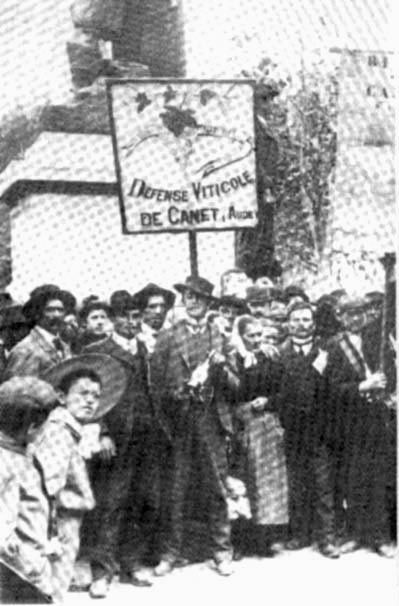
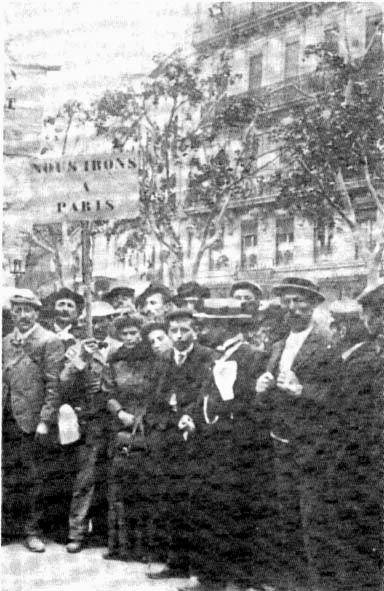
On the 19th and 20th of June major protests were staged in Narbonne. The mayor of Narbonne, Ernest Ferroul, was on the winegrowers' side and was put in prison. Instead of the government helping the situation, they sent 25,000 soldiers and 8,000 calvalry who fired on the people of Narbonne. Seven died, including a young woman called Cécile Bourrel, only in Narbonne to visit her mother.
People were shocked and the government started to listen at last. Soldier sons of vignerons deserted from the army and local maires resigned their posts. One of the results of this crisis was the forming of co-operatives who then built the distinctive Cave Co-operatives that one finds in villages. Canet, established in 1919, was one of the first, fourth behind Lézignan which was up and running by 1909. The idea was to cut out the wealthy vignerons and negotiators so the winegrowers could control their end of the wine industry.
However small your vineyard, you can still today sell your crop to the Cave Co-operative. They weigh the grapes and test them for sugar, and pay the appropriate amount immediately. By 1921 our cave co-operative became a distillery serving seven villages. It used the poor quality wine to make marc, a white spirit a bit like vodka, but 96 % alcohol.
Unfortunately our flour mill was destroyed in 1926 - a short circuit caused a fire - and has never been re-built. It's interesting to see the part built in the 11th century by Guifred is still standing more securely the part built later. Since 1890 the mill had been producing 9750 kgs of flour per day and employing 20 workers.
In 1910 Canet council debated that financial help was given to old people in need, but what about the welfare of those at the beginning of their lives? They gave pregnant women financial support for the last 30 days of the pregnancy. This was forward thinking at the time, care for an unborn child which didn't exist until it was baptised.
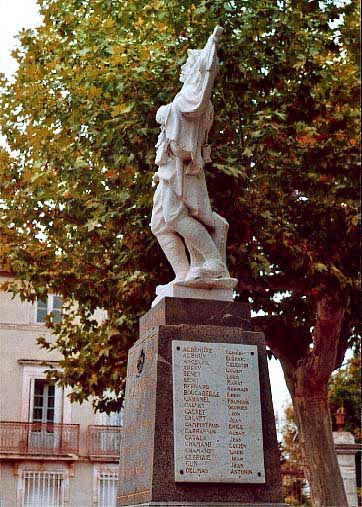
During the First World War, 44,000 men were mobilised in Aude; 11,000 never returned. In Canet the women, children and old men did the work. Many of the men who returned from the war were disabled for life; 32 soldiers died, three of them from the same family. By 1917 financial help was given to the children whose fathers had died.
Our war memorial was built on the site of the old Mairie in 1925.
By the 1930's prosperity had returned and there were many small businesses in Canet. You can see the remains of shops signs in the old part of the town. A lady of 85 years old, told me she remembered the blacksmith's near the church; she would come along and pet the horses waiting to be shod. There's still a hitching ring near the fontaine by the church, as well as an ancient horse-trough. Later, with the advent of the motor-car which blocked the tiny roads, the shops all moved onto the main avenue de Promenade.
In 1939 began the horror of another world war. After a year Paris was occupied and France cut in two. By October 1942 9,000 workers from Aude were sent to Germany on the Service de Travail Obligatoire - only 700 young men had the luck or courage to escape. As a result the first Resistance demonstration was held in Carcassonne; Christian clerics helped Jews to escape to Spain through our region.
From the start of 1943, deportation began to the "death camps" of Germany. Some 5 million people disappeared. Families were fatherless. After this war it became a dream of French people everywhere to have a conventional family, a pleasant home and clean and beautiful places in the open air for relaxation, a dream that has been acheived today by central government investment in Languedoc to build the holiday towns we know on the coast today and more recently, to promote the Cathar Castles and the Corbières, including Rennes-le-Château.
Inscrivez-vous au blog
Soyez prévenu par email des prochaines mises à jour
Rejoignez les 97 autres membres


